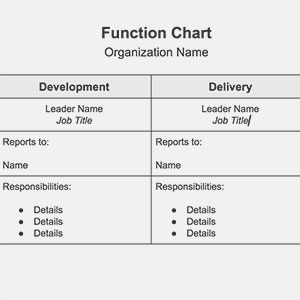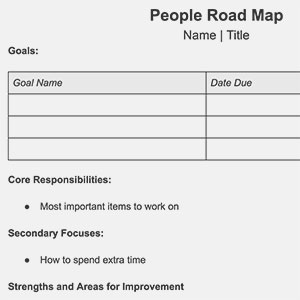You can figure out how to build a product, open a location or get the first customer.
When it’s time to grow the team, things start getting tricky. This guide will help you go from doing everything yourself to leading a team and being a good manager.
If you're a founder or CEO responsible for building the structure of your organization, use this guide as a template and customize it for your business.
If you're a new manager of a department, use this guide to better understand how company management should work and where your team fits in. Pay attention to the Objectives, and Process sections as they will help you effectively lead your own team.
Imagine you have an imaginary example business called Crazy Cookies, and you offer a cookie delivery subscription service. Your customers can pay a monthly fee and have fresh, delicious cookies delivered to their offices. I know… it’s genius!
Suppose you’re ready to hire your first employee to make deliveries. You’ve narrowed it down to two potential people:

 How do you decide who to hire? Both Beth and Tom have a mixture of good and bad qualities, so you need to determine which are most important to Crazy Cookies.
How do you decide who to hire? Both Beth and Tom have a mixture of good and bad qualities, so you need to determine which are most important to Crazy Cookies.
The qualities that are most important to your business are your values. Values are a key component of Culture, the first ingredient in the Manager Formula.
Culture is the behaviors and skills that are valued on your team. It includes 5 parts:
In order to make your team successful, you need to be intentional about culture. That means defining each of the 5 parts, writing them down and sharing them with everyone. Once your culture is on paper, it's easier to choose who to hire because you can simply check “Does this person share our values? Do they appreciate our story?”
You may be tempted to think “culture and values are too fluffy… let’s get serious!” While these concepts may seem soft right now, getting them right early will help you determine the right people to recruit, reward and retain for your team.
You are daydreaming about your Vision. The Vision is a statement that explains the purpose for why your team exists. Once that purpose is understood, it can guide your team to make effective decisions and hire the right people. For Crazy Cookies, your vision might be:
Having a defined vision will help you later to set the right goals and understand if you're making progress towards success.
In the early days, values come from the leaders. Consider the qualities and personality traits you respect most. For Crazy Cookies, you might use these:
These 4 words each have a clear definition that explains what the value means to you. Some of these are broad, while others can be very specific. Here’s another example:
 By creating values, you can use them to help with the 3 R’s: recruit, reward and release.
Defining your values gives you clarity. It’s easy to understand who belongs on the team, who should be promoted and who shouldn’t be there because you have a guiding light from your values.
By creating values, you can use them to help with the 3 R’s: recruit, reward and release.
Defining your values gives you clarity. It’s easy to understand who belongs on the team, who should be promoted and who shouldn’t be there because you have a guiding light from your values.
Customs happen whether you intentionally define them or not. Consider what customs you value and write them down. Some examples could include:
Entire companies and small teams all have unique customs. It often causes tension when someone doesn't follow the team's customs, which is why it's so important to intentionally define them.
When you hire new people, they don’t know the story. You need to share context of what’s happened in the past so new team members can benefit from lessons learned. In order to do that, you need to document your story so it can be passed down to new people. Here are the steps to document your story:
Once this document is created, make it a well designed PDF and share it with every new hire or job candidate you are considering for the team.
For some businesses, like a retail store that needs staff present to serve customers, the options will be more limited. If there is flexibility, different people will prefer unique variations of these options. Some can only work well in a quiet environment like a home office, while others thrive in a loud open bullpen of desks.
As you define your culture, decide which type of space aligns most with your values. Here’s a unique example from an equipment company in Colorado:

Suppose you’re ready to hire your first employee to make deliveries. You’ve narrowed it down to two potential people:

Beth is a hard worker and organized but rough around customers. She can be dismissive and uninterested.

Tom beams positivity and makes everyone laugh. However, he is often late to meetings and not prepared.
The qualities that are most important to your business are your values. Values are a key component of Culture, the first ingredient in the Manager Formula.
Culture is the behaviors and skills that are valued on your team. It includes 5 parts:
Vision
Values
Customs
Story
Space
You may be tempted to think “culture and values are too fluffy… let’s get serious!” While these concepts may seem soft right now, getting them right early will help you determine the right people to recruit, reward and retain for your team.
Vision
When you build something new, you likely have a few reasons “why” in your head. It might be to solve a problem you’ve experienced or make a hard thing easier for your customers. You likely daydream about how your business could grow and succeed by solving this problem.
You are daydreaming about your Vision. The Vision is a statement that explains the purpose for why your team exists. Once that purpose is understood, it can guide your team to make effective decisions and hire the right people. For Crazy Cookies, your vision might be:
“To bring joy to office workers through fresh baked treats”
Values
Every company has a unique set of values. These are the traits and behaviors that people in the company live by. They are the beating heart of the company’s culture.
In the early days, values come from the leaders. Consider the qualities and personality traits you respect most. For Crazy Cookies, you might use these:
Curiosity
We try new recipes to improve our cookies.
Energy
We are excited when we bake and deliver.
Excellence
We are proud to put our name on our cookies.
Dedication
We wake up early to bake fresh cookies.

Example:
Grant George, CTO at Set the Set
Set the Set is a software company that lets music fans request their favorite songs for upcoming concerts. One of their values is “Fans First,” which means that in every decision, they consider “is the choice we are making best for fans?”
Grant George, CTO at Set the Set
Set the Set is a software company that lets music fans request their favorite songs for upcoming concerts. One of their values is “Fans First,” which means that in every decision, they consider “is the choice we are making best for fans?”
Recruit: Hire people that share your values.
Reward: Promote people who exemplify your values.
Release: Let go of people who don’t align with your values.
Customs
Your values come to life in your customs. These are the specific ways people in your company behave to align with your values. For example, if one of your values is “Dedication: waking up early to bake fresh cookies daily,” you might be frustrated with a baker who can’t drag himself out of bed until 10am. If the custom is that everyone at the bakery comes in early, then that is the behavior new people need to adopt.
Customs happen whether you intentionally define them or not. Consider what customs you value and write them down. Some examples could include:
We communicate best in person or over the phone, not by text message
We are blunt when sharing feedback, and everyone uses constructive criticism
We leave at 3pm to attend kids’ sports games as long as we get our work done
Story
Every organization has a unique story and history. When it’s just you, the story is simple because you are the main character. The early history may motivate you to continue to grow the company, and remind you of how it all started. The story often influences future behavior because of past experiences.
When you hire new people, they don’t know the story. You need to share context of what’s happened in the past so new team members can benefit from lessons learned. In order to do that, you need to document your story so it can be passed down to new people. Here are the steps to document your story:
Write a list of milestones for your company, such as getting the first customer
For each item on the list, think back to what it felt like and describe the story
Include details like who was there, what was said and how you felt at the time
Put all of the milestone stories together in a timeline
Space
Where the business is located and where people work has a big impact on culture. Early on, you need to make some important decisions:
Do you want everyone to come to an office every day?
Do you want to hire people in different locations to work remotely?
Will the work day be defined as 9-5, or more flexible?
As you define your culture, decide which type of space aligns most with your values. Here’s a unique example from an equipment company in Colorado:

Example:
John Ford, CEO at eGym North America
eGym is a global company based in Germany. When opening a U.S. office, the initial idea was NYC for easy travel to Europe. Instead, eGym chose Boulder, CO because it shares their value of an energetic outdoors environment.
John Ford, CEO at eGym North America
eGym is a global company based in Germany. When opening a U.S. office, the initial idea was NYC for easy travel to Europe. Instead, eGym chose Boulder, CO because it shares their value of an energetic outdoors environment.






 Let’s return to your example company, Crazy Cookies. Suppose in the very early days, you baked as many cookies as you could and tried hard to sell them. You had a long list of things to do to grow the company, but there was no clear timeline. Instead, it was “do as much as you can, as fast as possible.” That’s how most companies operate early on.
Let’s return to your example company, Crazy Cookies. Suppose in the very early days, you baked as many cookies as you could and tried hard to sell them. You had a long list of things to do to grow the company, but there was no clear timeline. Instead, it was “do as much as you can, as fast as possible.” That’s how most companies operate early on.




 An All Hands meeting is just what it sounds like: getting all team members together.
An All Hands meeting is just what it sounds like: getting all team members together.




